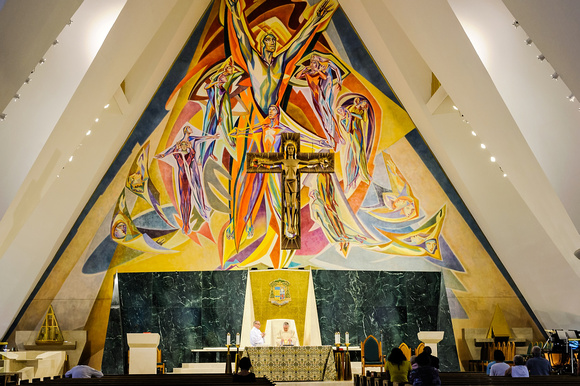For today, given the conditions of my age, I could not prepare a great, real address, as one might expect, but rather I thought of chatting about the Second Vatican Council, as I saw it.Given the momentous import of the past few days, and all the confusion, misapprehension, distortion, ignorant and uninformed speculations spouting from the talking heads, and virulent attacks on the Holy Father, it is all the more important for us to understand precisely what is at stake and what Pope Benedict XVI is telling the Church in these last weeks of his pontificacy.
Today, on 14 February 2014, the Feast of Saint Valentine the Martyr, Pope Benedict spoke extemporaneously for 45 minutes to the clergy of Roman of his reflections on the Second Vatican Council. The text is from the Vatican Radio translation, worth reading in its entirety, and brought to my attention from Jon Haines' Battle for the Core of the World blog.
The Holy Father spoke candidly and informally about his experiences of the Council, and helps us all to understand the context of the Council's dynamics and the intent of the various documents. Most telling is his concluding remarks, where he spoke of the the need and opportunity to recover the authentic vision of the Council Fathers -- what the Holy Father calls,"the Council of the Fathers - the true Council" from "the Council of the media". He calls the latter "the virtual Council", a council which did not "take place within the world of faith but within the categories of the media of today, that is outside of the faith, with different hermeneutics. It was a hermeneutic of politics."
This popular interpretation, broadcast around the world, infected the very heart of the Church in the sacred liturgy, which was made into something banal (parenthetically, as our sacred architecture, sacred arts, and sacred music were banalized in the "spirit of Vatican Two"): "there was no interest in the liturgy as an act of faith, but as a something to be made understandable, similar to a community activity, something profane."
And the Holy Father acknowledges that this "virtual Council was stronger than the real Council" and "created many calamities, so many problems, so much misery, in reality: seminaries closed, convents closed, liturgy trivialized ... "
And yet the Holy Father leaves us with a vision of hope and a task, that despite the hijacking of the Vatican Council by "the council of the media ... that the true Council with the power of the Holy Spirit is realized and Church is really renewed."
(Indeed, I have long held that the Liturgical Movement since the Second Vatican Council has been liturgically contraceptive: the old 70s style liturgists have been incapable of even reproducing themselves. The liturgical designers who wanted centralized liturgy, and barren, austere, whitewashed barns are finally out of fashion, and no one today seems particularly interested in their project. Rather, an entire generation of younger men and women who are spiritual children of Blessed John Paul the Great are now longing for beauty, mystery, reverence, and true worship --and are now starting to reject the felt banners for stained glass, looking for profound music in place of the liturgical jingles we have been forced to sing, embracing the new dignified translation of the Roman Missal, open to the Extraordinary Form of the Roman Rite, and wanting again "churches that look like churches" -- significant and meaningful places to worship Our Lord in the Holy Mass.)
So we can take great hope and strength from these parting words of our Holy Father, trusting in the continued work of Christ to renew the Church, and understanding it is our generation that is being called to implement the authentic vision of the Council Fathers:
But the real strength of the Council was present and slowly it has emerged and is becoming the real power which is also true reform, true renewal of the Church. It seems to me that 50 years after the Council, we see how this Virtual Council is breaking down, getting lost and the true Council is emerging with all its spiritual strength. And it is our task, in this Year of Faith, starting from this Year of Faith, to work so that the true Council with the power of the Holy Spirit is realized and Church is really renewed. We hope that the Lord will help us. I, retired in prayer, will always be with you, and together we will move ahead with the Lord in certainty. The Lord is victorious.











